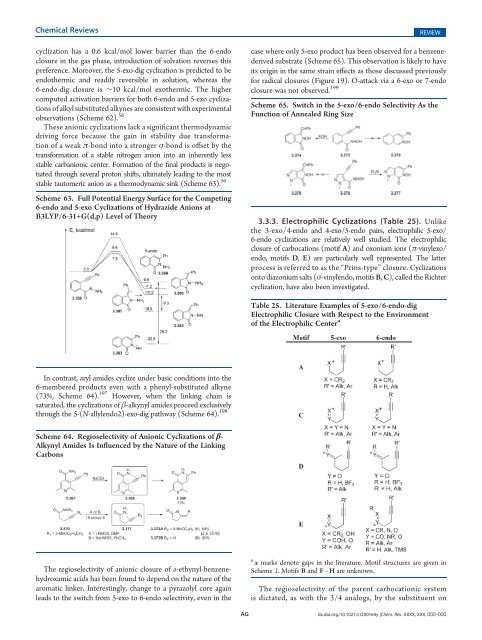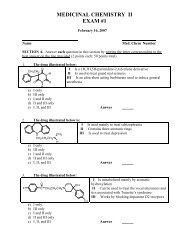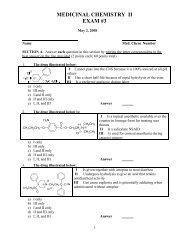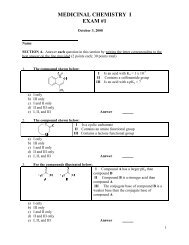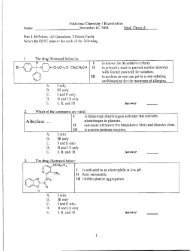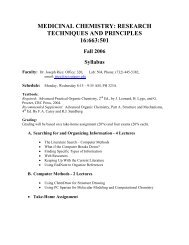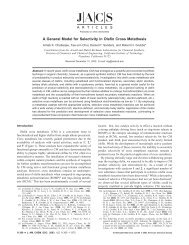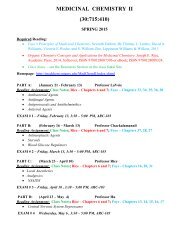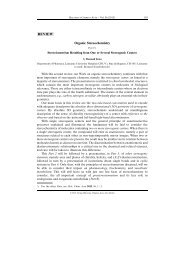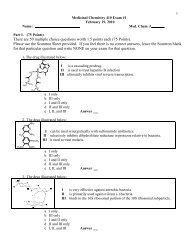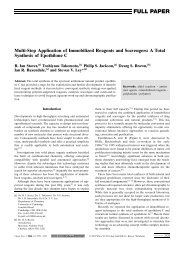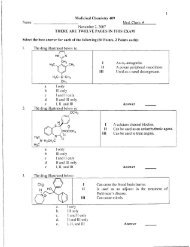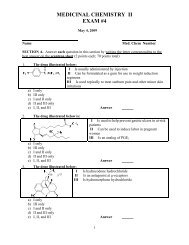Baldwin's Rules - Department of Medicinal Chemistry
Baldwin's Rules - Department of Medicinal Chemistry
Baldwin's Rules - Department of Medicinal Chemistry
You also want an ePaper? Increase the reach of your titles
YUMPU automatically turns print PDFs into web optimized ePapers that Google loves.
Chemical Reviews REVIEW<br />
cyclization has a 0.6 kcal/mol lower barrier than the 6-endo<br />
closure in the gas phase, introduction <strong>of</strong> solvation reverses this<br />
preference. Moreover, the 5-exo-dig cyclization is predicted to be<br />
endothermic and readily reversible in solution, whereas the<br />
6-endo-dig closure is ∼10 kcal/mol exothermic. The higher<br />
computed activation barriers for both 6-endo and 5-exo cyclizations<br />
<strong>of</strong> alkyl substituted alkynes are consistent with experimental<br />
observations (Scheme 62). 56<br />
These anionic cyclizations lack a significant thermodynamic<br />
driving force because the gain in stability due transformation<br />
<strong>of</strong> a weak π-bondintoastrongerσ-bond is <strong>of</strong>fset by the<br />
transformation <strong>of</strong> a stable nitrogen anion into an inherently less<br />
stable carbanionic center. Formation <strong>of</strong> the finalproductsisnegotiated<br />
through several proton shifts, ultimately leading to the most<br />
stable tautomeric anion as a thermodynamic sink (Scheme 63). 56<br />
Scheme 63. Full Potential Energy Surface for the Competing<br />
6-endo and 5-exo Cyclizations <strong>of</strong> Hydrazide Anions at<br />
B3LYP/6-31+G(d,p) Level <strong>of</strong> Theory<br />
In contrast, aryl amides cyclize under basic conditions into the<br />
6-membered products even with a phenyl-substituted alkyne<br />
(73%, Scheme 64). 197 However, when the linking chain is<br />
saturated, the cyclizations <strong>of</strong> β-alkynyl amides proceed exclusively<br />
through the 5-(N-allylendo2)-exo-dig pathway (Scheme 64). 198<br />
Scheme 64. Regioselectivity <strong>of</strong> Anionic Cyclizations <strong>of</strong> β-<br />
Alkynyl Amides Is Influenced by the Nature <strong>of</strong> the Linking<br />
Carbons<br />
The regioselectivity <strong>of</strong> anionic closure <strong>of</strong> o-ethynyl-benzenehydroxamic<br />
acids has been found to depend on the nature <strong>of</strong> the<br />
aromatic linker. Interestingly, change to a pyrazolyl core again<br />
leads to the switch from 5-exo to 6-endo selectivity, even in the<br />
case where only 5-exo product has been observed for a benzenederived<br />
substrate (Scheme 65). This observation is likely to have<br />
its origin in the same strain effects as those discussed previously<br />
for radical closures (Figure 19). O-attack via a 6-exo or 7-endo<br />
closure was not observed. 199<br />
Scheme 65. Switch in the 5-exo/6-endo Selectivity As the<br />
Function <strong>of</strong> Annealed Ring Size<br />
3.3.3. Electrophilic Cyclizations (Table 25). Unlike<br />
the 3-exo/4-endo and 4-exo/5-endo pairs, electrophilic 5-exo/<br />
6-endo cyclizations are relatively well studied. The electrophilic<br />
closure <strong>of</strong> carbocations (motif A) and oxonium ions (π-vinylexo/<br />
endo, motifs D, E) are particularly well represented. The latter<br />
processisreferredtoasthe“Prins-type” closure. Cyclizations<br />
onto diazonium salts (σ-vinylendo, motifs B, C), called the Richter<br />
cyclization, have also been investigated.<br />
Table 25. Literature Examples <strong>of</strong> 5-exo/6-endo-dig<br />
Electrophilic Closure with Respect to the Environment<br />
<strong>of</strong> the Electrophilic Center a<br />
a x marks denote gaps in the literature. Motif structures are given in<br />
Scheme 1. Motifs B and F H are unknown.<br />
The regioselectivity <strong>of</strong> the parent carbocationic system<br />
is dictated, as with the 3/4 analogs, by the substituent on<br />
AG dx.doi.org/10.1021/cr200164y |Chem. Rev. XXXX, XXX, 000–000


